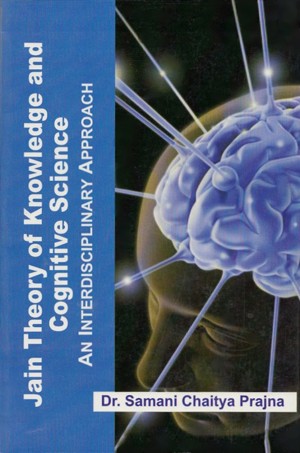Knowledge is one of the exclusive characteristics of the soul. The highest degree of that knowledge is Omniscience. It is one and the whole. Soul always possesses this knowledge but soul is veiled by the particles of karma. Due to this veil on knowledge, soul cannot illuminate itself completely. On the basis of presence and absence of this veil, knowledge is classified into various kinds. According to Jain philosophy, there are mainly five types of knowledge and these five types of knowledge have further sub-divisions. The process of knowing the things is also considered as the part of the knowledge. The five basic divisions of the knowledge are as follows:
- Perceptual knowledge: knowledge that is acquired through senses and mind.
- Verbal knowledge: knowledge that is acquired through sound, hints, symbols and scriptures etc.
- Clairvoyance: knowledge of material objects that is acquired directly through the soul. In humans clairvoyance is acquired through spiritual discipline, whereas for the inhabitants of heaven and hell, it is inborn.
- Mind Reading: It is an act of seeing the objects of other's mind. This knowledge is acquired by ascetics at a high level of spirituality.
- Omniscience: Knowledge of all the substances in all their modes of past, present and future is kevalajñāna.[22]
The five types of knowledge have been divided into two categories of direct cognition (pratyakṣa) and the indirect cognition (parokṣa) as mentioned in Nandīsūtra. The first two types of mati and śruta are indirect cognitions while the remaining three are direct-cognitions.
The instrument of cognition is of two kinds - Direct knowledge and Indirect knowledge.
The knowledge that occurs directly through sense organs and soul is known as direct or pratyakṣa.
The knowledge that does not occur through sense organs and soul is known as indirect or parokṣa.
As many kinds of truthful knowledge are there so many kinds of organ of knowledge are also there. Broadly, they can be classified into two types - direct and indirect.
The types of indirect (from soul point of view) knowledge are as follows:
1. Perceptual Knowledge (Matijñāna)
The first among the five types of knowledge is empirical or perceptual knowledge. It has been defined in 'Jain Siddhānta Dīpīkā'[23] as:
'Indriyamanonibandhanaṁ matiḥ'
The knowledge acquired through senses and mind is perceptual knowledge. The word 'ābhinibodhika' also has been used for perceptual knowledge in Jain scriptures.
Perceptual knowledge arises either from the senses alone, the mind alone or from the two acting together. There are beings without a mind such as plants, trees and some lower animals whose knowledge is produced necessarily through their sense alone. Plants and trees have only one sense, the tactile sense. Therefore, their perception is produced by touch alone.
In human beings however, perceptual knowledge is sometimes produced by the joint activity of the senses and the mind and at other times by the activity of the mind alone. For instance, the empirical knowledge that 'this is a table' is produced by the collaboration of the sense of sight and the mind where as mere remembering what the table looked like requires only the mind to act. There is also a variety of empirical knowledge that is instinctive, such as the ability of a plant to grow towards the light or of a creeper towards the support.[24]
The perceptual or empirical knowledge can be as low as mere instincts in lower organisms and as high as gifted intelligence in humans. The memory can also be as short as experience of the stimuli which is not retained at all and as long as the memories of many past lives. However, the major classifications are as follows Divisions and Subdivisions of Empirical or Perceptual Knowledge:
Mainly two divisions of empirical knowledge have been described:
- Depending on the verbal symbol is called śrutaniśrita
- Not depending on the verbal symbol called aśrutanisrita.
Depending on the Verbal Symbol (śrutaniśrita)
Depending on the verbal symbol knowledge is of four kinds:
- avagraha (Sensation)
- īhā (Speculation)
- avāya (Perceptual judgment)
- dhāraṇā (Retention).
1. Sensation
Sensation refers to the cognition of a generic character of the object as a result of the contact between the sense and the object. There occurs sensation, the cognition of the pure general character without the manifestation of any particular characteristic on the contact due to situation of the sense-organ and the object at proper conditions as place and other criteria like light, etc. being filled. After this process of sense-object there occurs the indeterminate cognition of the general character (of the) object. This is called 'avagraha' or sensation.[25]
2. Speculation
Further analysis of the sensory data after sensation is known as īhā or speculation.[26]
Speculation is the experience that 'This must be that.' Speculation is an experience which brings up the rear of doubt 'this is that or anything else', through agreement and difference in respect of a characteristic feature, for example, 'it must be a sound'.[27]
Speculation is an attitude of the mind which leads to the determination of the specific character of the object by laying emphasis upon the real characteristics that are perceived and the elimination of the unreal attributes that are not cognized.
3. Perceptual Judgment
Perceptual judgment is the specific determination (of the object), viz. 'this is that.[28] For instance, 'it is a sound indeed'.
4. Retention
Retention is the imprint of the identification of the object, creating an impression in the mind, which is experienced as memory. The commentary of Tattvārtha Sutra explains retention with synonyms such as continued cognition, memory, retention and determination.[29] Thus the four stages constitute the complete process of mental activity during the process of perception.
According to Jain texts intellect are of various types. As the part of perceptual knowledge it is known as perceptual cognition not depending on the verbal symbol
(Aśrutaniśrita). The perceptual cognition not depending on verbal symbol falls under four categories as follows:
- Autpattikī buddhi (Intellect of instantaneous comprehension)
- Vainayikī buddhi (Intellect born of faithful service)
- Kārmikī buddhi (Intellect developed by practical experience)
- Pāriṇāmikī buddhi (Intellect of mature experience).[30]
- Autpatikī Buddhi or Intellect of Instantaneous Comprehension
The instantaneous comprehension apprehends the unseen and the unheard of object.- Vainayikī Buddhi or Intellect born of Faithful Service
The Vainayikī is so called because it is an intellect born of training (in modesty, humility and loyalty to the teacher).[31]- Kārmikī Buddhi or Intellect developed by Practical Experience
The Kārmikī is so called because it is (an intellect) developed by practical experience. Practical experience means repeated practice and the intellect born of such practice is called Kārmikī.- Pāriṇāmikī buddhi or Intellect of Mature Experience.
The Pāriṇāmikī is so called because it is (the intellect) born of maturity. Maturity means maturity in respect of age.[32]Memory, recognition, reasoning and apprehension incorporate the various aspects of empirical knowledge.[33]
2. Verbal Knowledge (Śrutajñāna)
Śrutajñāna comes second in the list of the five types of knowledge. The cognition capable of communicating itself to other through word, gesture and the like. It is called verbal knowledge.[34]
Of the five types of knowledge, four serve one's own purpose only but articulate knowledge being verbal in nature, is useful for others as well.
Omniscience is just like a mirror. Everything is directly visible in it, but so far as imparting knowledge to others is concerned, only verbal knowledge has to be resorted. Therefore, it is of greater importance than the other four kinds of knowledge.
3.-4. Direct Knowledge
The cognition, which arises from the soul without any external help, is direct and that depending upon external cause is indirect.[35] The direct knowledge is independent of all factors, commonly held as the cause of knowledge. It apprehends the objects that are remote, past, futuristic, minute, hidden or otherwise uncognizable through the external senses.
1. Clairvoyance (Avadhijñāna)
According to Jainism, there are three kinds of supernormal consciousness as indicated within the sphere of direct cognitions. The first is known as Avadhijñāna is limited to the material objects. Avadhijñāna is the supernormal knowledge of material objects. It is known as avadhi because, its sphere of apprehension is limited.[36] All cognitions related with Avadhi are produced direct by the soul. The senses do not play any role in this process.
2. Mind Reading (Manaḥparyāya Jñāna)
The second is known as Manaḥparyāya jñāna, where one can know the other's mind. It is subtler and particular than the previous one. Manaḥparyāya means the modes of mind. The knowledge of the mental modes is called Manaḥparyāya jñāna[37] It is also called manahparyava (prākṛta-Manapajjava) or Manaḥparyāya.
3. Omniscience (Kevala jñāna)
The third is kevalajñāna i.e. omniscience refers to knowledge of all substances in all their modes, past, present and future.[38] Three varieties of knowledge, clairvoyance, mind-reading and omniscience are considered innate because they exist independently of the senses, mind and words. Clairvoyance and mind-reading result from partial suppression and partial elimination of the relevant karma. Strictly speaking, only omniscience is perfectly innate because it alone arises out of the total elimination of knowledge-covering karma and therefore knows everything, past, present and future.
 Samani Chaitya Pragya
Samani Chaitya Pragya

